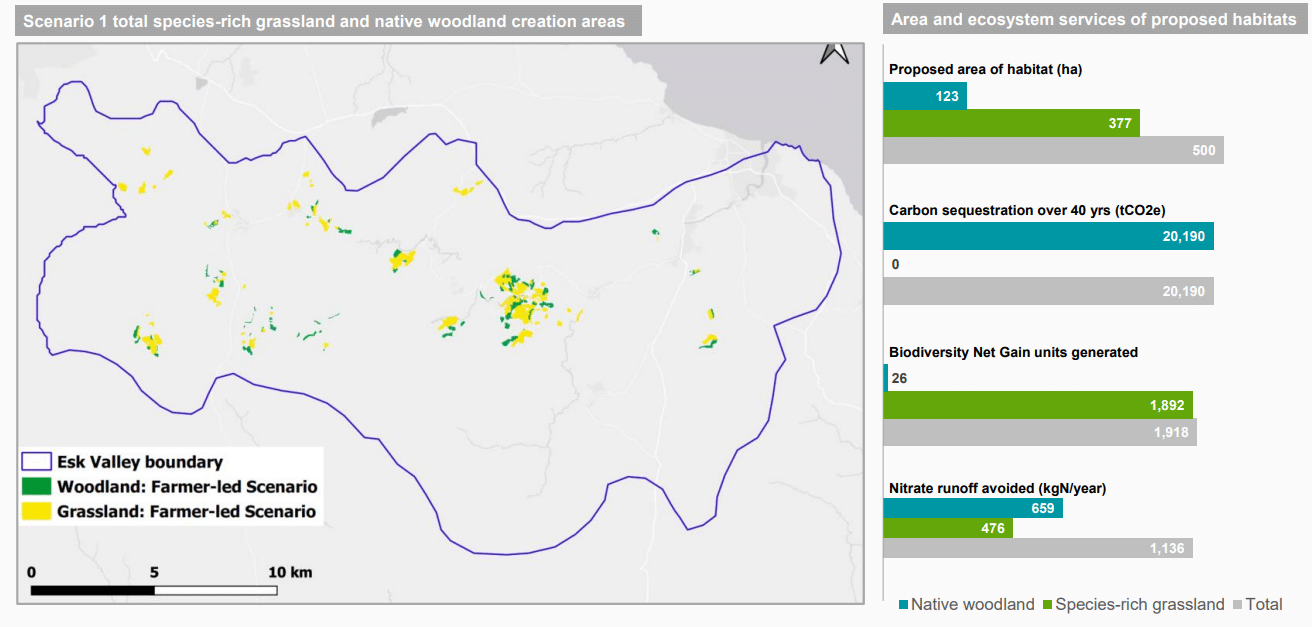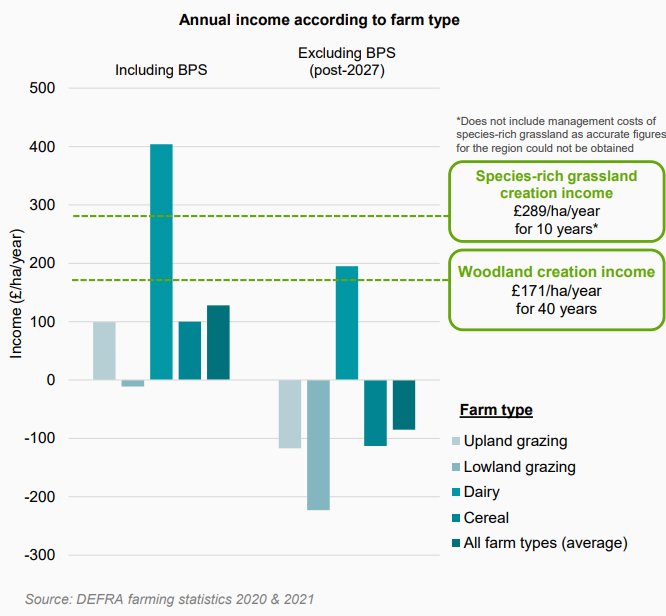Project Summary
The North York Moors National Park Authority and Palladium have been working to develop a blueprint for catchment-scale nature restoration, working with a farmer group in the Esk Valley. By exploring options for generating ecosystem services with the farmers and undertaking market research, it has identified a concept for a ‘project aggregation facility’ that could address certain barriers to nature restoration using private finance. The project links to Revere, a UK-wide collaboration between National Parks and Palladium that aims to raise private capital to fund nature restoration.
Acknowledgement
With many thanks for her time and insight:
Briony Fox, Director of Conservation, North York Moors National Park Authority
Date Published: 19/04/2023
Identifying sellers
The Esk Valley within the NYMNPA was chosen as the pilot area, with the project team working closely with farmers of the Esk Valley Farmers Group (‘the Farmers Group’).
This group hosts 52 farmers that manage over 10,000 hectares. Approximately 60% of their land is managed under tenancy agreements and the land is largely traditional upland, low intensity livestock grazing on improved grassland with some interspersed rotational arable farming.
Briony Fox, Director of Conservation & Climate Change at NYMNPA, says that the NYMNPA has a strong working relationship with the farmers across its boundary – “the National Park Authority doesn’t own a lot of land, so anything that we want to accomplish, we work directly with the farmers.”
When the project was being scoped, Fox says that the Farmers Group was already discussing the use of nature finance and environmental markets, amid concerns over the loss of the Basic Payment Scheme. However, there were strong suspicions over issues such as corporate land acquisition to use as carbon or habitat banks, and environmental mismanagement. Many of the farmer tenants were also concerned with the idea of landlords taking farmland back in hand to conduct their own trades or offsetting.
Fox and the project team attended one of the farmer facilitation meetings in early 2021 to seek broad support, ahead of submitting a bid for project development funding to the NEIRF (see Milestone 1). Around 30-40 farmers were in attendance.
At a high level, Fox explained the project’s aims, the planned process of engagement and why the farmers’ support was essential, stressing that if the farmers were not interested then the project team would not be submitting the funding bid.
Fox also explained that there would be no immediate financial return, but instead this project would allow the farmers to understand more about the value of their natural capital. scope financial and environmental possibilities, and develop a knowledge base around nascent environmental markets. The farmers were also encouraged to consider participating by the farmer facilitator of the group, Fraser Hugill, who had been working with the farmers for the past eight years.
As a result, six farmers signed initial letters of support that the project team had drafted, and others expressed an openness to working on the project. Fox comments that this was all the project needed at the time to move forward and that keeping this initial ask simple was important, given farmers’ general time and resource pressures.
Building restoration scenarios
The project team kept the Group updated on its progress, but only approached the farmers again after concluding its natural capital accounting in September 2021 (see Milestone 1), which Fox says was a timely month to engage in terms of the farming calendar.
The team presented its natural capital findings of the Esk Valley, and asked the farmers if they would like a more detailed review of their own farm holdings. 21 farmers agreed to participate, with most being smaller farmholders and a few bigger estates. Natural Capital Research subsequently produced similar natural capital reports for each of the farm holdings – this took around two months to complete and involved desk-based analysis.
Fraser Hugill and the NYMNPA team then coordinated one-to-one drop-in sessions in January 2022 with the Esk Valley farmers to identify areas for woodland and species-rich grassland creation on their holdings, two habitat types that the natural capital accounting and market research indicated may be used to generate private revenue streams.
Collectively, the farmers identified 122 hectares of potential native woodland creation and 377 hectares of species-rich grassland creation – generating over 20,000 tonnes of CO2e tonnes of carbon sequestered over 40 years, 1,900 BNG units, and 1,100 Kg of avoided nitrate run-off.
Building on this ambitious ‘farmer-led’ proposal, Natural Capital Research then identified further areas of habitat creation that, if delivered, would generate significant environmental gain. This was supplemented by soil sampling across each of the landholdings to provide more certainty about the data, which took around one month. This ‘enhanced scenario’ outlined 209 additional hectares of woodland and 182 hectares of grassland.
Scenario 1 (Farmer Led) Total Species-rich Grassland and Native Woodland Creation Areas, Esk Valley Project Final Report for NEIRF, Revere, 2023
After presenting back these advanced scenarios in March 2022, eight or so farmers also took up the project team’s offer of ‘ground-truthing’ these findings through farm visits with NYMNPA and Natural Capital Research. Fox comments that, through this period of design and consultation, the farmers became increasingly interested about what others were considering and acting on within their scenarios.
This exercise helped the project team to assess what was more likely in the advanced scenarios and highlighted the need to avoid overburdening farmers with complex interventions and multiple agreements. The project team theorized that an intermediary to pool and manage the delivery of smaller chunks of environmental interventions across the landscape would help farmers with this barrier.
Modelling farmer income
Palladium used these restoration scenarios to build economic models that would demonstrate whether these were financially viable for farmers. A key feature of this exercise was to model the loss of the BPS, which Defra’s national statistics show is a vital for many farmers – on average, all farm types but dairy farming enterprises are set to be loss-making following the phase out of BPS payments by 2027.
Palladium used both the ‘farmer led’ and ‘enhanced’ scenarios along with Defra’s national farm income data to model private revenue from the sale of Woodland Carbon Code (WCC) units over 40 years, using a carbon price of £30/tCO2e. This was blended with the England Woodland Creation Grant at a 30/70% split for carbon unit sales and grant funding respectively.
For species rich grassland creation, Palladium used the relevant Countryside Stewardship Higher Level Scheme payments as a proxy for the upcoming ELMS Local Nature Recovery payments, which it had established would support species-rich grassland.
From the ‘farmer led’ scenario, Palladium calculated each of these income sources at £171 and £289 per hectare for woodland creation and species rich grassland creation respectively – net of costs. All cases for habitat creation indicated that implementation could be profitable for farmers. However, when presenting these findings back to the farmers in July 2022, there was a perception among many that proposed income per hectare would not currently encourage them to transition their farm businesses. This was especially true for farms (mainly tenanted) where only species-rich grassland creation had been proposed.
Annual income according to farm type, Esk Valley Project Final Report for NEIRF, Revere, 2023
Fox says that further engagement with Esk Valley farmers is needed to better understand how current and future incomes compare to those proposed, as well as establishing income rates for habitat creation that represent a compelling and sustainable farm business transition offer.
Identifying risks to farmers
While consulting with the farmers on the economic models, the project team also undertook a risk mapping exercise to identify the farmers’ perceptions of risk. This mapping captured both the likelihood of certain risks materialising and the severity of the impact, which allowed them to generate a score for each risk. The key potential risks were sorted into four categories:
- Reputational – including the potential loss of food production from transitioning out of traditional agriculture, and impact on local stakeholders such as commoners’ loss of access. XXXXXXXXXXXXXXXXXXXXXXXXXXXXXXXXXXXXXXXXXXXXXXXXXXXXXXXXXXXXXXXXXXXXXXXXX
- Compliance – including policy changes favouring food production, rules on additionality and the ability to blend public grants with private finance. XXXXXXXXXXXXXXXXXXXXXXXXXXXXXXXXXXXXXXXXXXXXXXXXXXXXXXXXXXXXXXXXXXXXXXXXXXXXXXXXXXXXXXXXXXXXX
- Operational – focused on the risks to project delivery and the liabilities to farmers over the 40+ year timeframe, including force majeure and failure to maintain the habitats. XXXXXXXXXXXXXXXXXXXXXXXXXXXXXXXXXXXXXXXXXXXXXXXXXXXXXXXXXXXXXXXXXXXXXXXXXXXXXXXXXXX
- Financial – including debt liabilities to cover initial expenses, the opportunity costs of giving up land over several decades, and the vagaries of local demand, such as the sale of BNG units. XXXXXXXXXXXXXXXXXXXXXXXXXXXXXXXXXXXXXXXXXXXXXXXXXXXXXXXXXXXXXXXXXX
Of these risks, the chief group was Compliance, which farmers perceived were very likely to take place and having a major input on their livelihoods. The project team also discussed factors that would mitigate these risks, but these only helped bring risks acceptance to an ‘adequate’ level, indicating more work and clarity is needed to get farmers comfortable with these risks.
Key learnings and next steps
Concluding the project in 2022, the project team hope this work has signalled to farmers the possibilities and support available for opportunities over the next few years, such as the ELMS and the carbon codes in development.
The project team outlined some immediate public funding opportunities for farmers who want to act on their restoration scenarios, some of which can also be combined with the Woodland Carbon Code. One output of the project was that a few of the farmers used their scenarios and formed a sub-group to put in an application for the Farming in Protected Landscape programme, which was announced in June 2021.
In the longer term, Palladium and their National Parks partners hope to build on the concept of an aggregation vehicle to deliver nature restoration at scale. Key feedback from land managers in the Esk Valley and other National Parks indicates that participation in ecosystem service markets will be determined by the simplicity of application and access to funds. The team also highlights the need for this to include mechanisms that direct financial benefits to tenant farmers, not just landowners.
As a result, the project team will be exploring this concept in further detail across the National Parks, including the iteration of their nature recovery strategies, the assessment of all funding routes available and the development of a governance structure for a National Park-level funding platform.


